The Deportation of the Hungarian
Jews
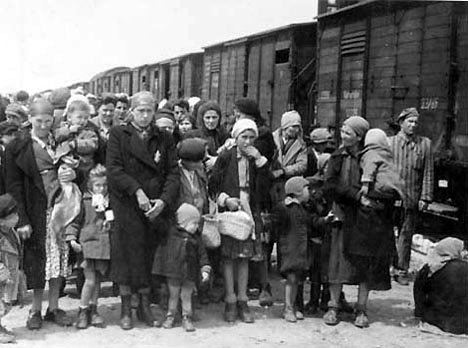 Hungarian Jews arriving
at Auschwitz-Birkenau, May 26,1944
Hungarian Jews arriving
at Auschwitz-Birkenau, May 26,1944
It was not until May 1944, when the Hungarian
Jews were deported, that Auschwitz-Birkenau became the site of
the largest mass murder in modern history and the epicenter of
the Final Solution. In 1942, there were 2.7 million Jews murdered
by the Nazis, including 1.6 million at the Operation Reinhard
camps, but only 200,000 Jews were gassed at Auschwitz that year
in two old converted farm houses. This information is from the
book "Auschwitz, a New History" by Laurence Rees, published
in 2005.
Almost one half of all the Jews that
were killed at Auschwitz were Hungarian Jews who were gassed
within a period of 10 weeks in 1944. Up until the Spring of 1944,
it had been the three Operation Reinhard camps at Treblinka,
Belzec and Sobibor, that were the main Nazi killing centers for
the Jews, not Auschwitz.
The order to round up the Hungarian Jews and
confine them in ghettos was signed by Lazlo Baky of the Royal
Hungarian government on April 7, 1944. Jews in Hungary had been
persecuted
since 1092 when Jews were forbidden to marry Christians.
The deportation of the Hungarian Jews
began on April 29, 1944 when a train load of Jews were sent to
Birkenau on the orders of Adolf Eichmann, according to the book
by Laurence Rees. According to The Holocaust Chronicle, a huge
book published in 2002 by Louis Weber, the CEO of Publications
International, Ltd., another train filled with Hungarian Jews
left for Birkeanu on April 30, 1944; the two trains with a total
of 3,800 Jews reached Birkenau on May 2, 1944. There were 486
men and 616 women selected to work; the remaining 2698 Jews were
gassed upon arrival.
On May 8, 1944, former Commandant Rudolf
Höss (Hoess) was brought back to Auschwitz-Birkenau to supervise
the further deportation of the Hungarian Jews. The next day,
Höss ordered the train tracks to be extended inside the
Birkenau camp so that the Hungarian Jews could be brought as
close as possible to the gas chambers.
According to Laurence Rees, in his book
"Auschwitz, a New History," the first mass transport
of Hungarian Jews left on May 15, 1944 and arrived at Birkenau
on May 16, 1944. The mass transports consisted of 3,000 or more
prisoners on each train.
In October 1940, Hungary had become allies
with the Axis powers by joining the Tripartite Pact. Part of
the deal was that Hungary would be allowed to take back northern
Transylvania, a province that had been given to Romania after
World War I. Hungarian soldiers participated in the German invasion
of the Soviet Union in June 1941.
On April 17, 1943, after Bulgaria, another
ally of Germany, had refused to permit their Jews to be deported,
Hitler met with Admiral Miklos Horthy, the Hungarian leader,
in Salzburg and tried to persuade him to allow the Hungarian
Jews to be "resettled" in Poland, according to Martin
Gilbert in his book entitled "Never Again." Admiral
Horthy rejected Hitler's plea and refused to deport the Hungarian
Jews.
From the beginning of the persecution
of the Jews by the Nazis in 1933, until March 1944, Hungary was
a relatively safe haven for the Jews and many Jews from Germany,
Austria, Slovakia and Poland sought refuge within its borders.
However, in 1938, Hungary had enacted laws similar to the laws
in Nazi Germany, which discriminated against the Jews.
On September 3, 1943, Italy signed an
armistice with the Allies and turned against Germany, their former
ally. Horthy hoped to negotiate a similar deal with the Western
allies to stop a Soviet invasion of Hungary.
"Sonderkommando Eichmann,"
a special group of SS soldiers under the command of Adolf Eichmann,
was activated on March 10, 1944 for the purpose of deporting
the Hungarian Jews to Auschwitz; the personnel in this Special
Action Commando was assembled at the Mauthausen concentration
camp in Austria and then sent to Hungary on March 19, 1944 during
the celebration of Purim, a Jewish holiday.
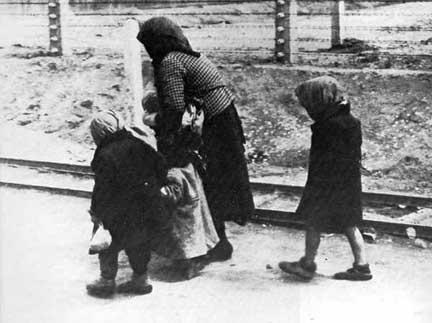 Famous photo of Hungarian
Jews walking to the gas chamber
Famous photo of Hungarian
Jews walking to the gas chamber
On March 18, 1944, Hitler had a second
meeting with Horthy at Schloss Klessheim, a castle near Salzburg
in Austria. An agreement was reached in which Horthy promised
to allow 100,000 Jews to be sent to the Greater German Reich
to construct underground factories for the manufacture of fighter
aircraft. These factories were to be located at Mauthausen, and
at the eleven Kaufering subcamps of Dachau. The Jews were to
be sent to Auschwitz, and then transferred to the camps in Germany
and Austria.
When Horthy returned to Hungary, he found
that Edmund Veesenmayer, an SS Brigadeführer, had been installed
as the effective ruler of Hungary, responsible directly to the
German Foreign Office and Hitler.
On March 19, 1944, the same day that
Eichmann's Sonderkommando arrived, German troops occupied Hungary.
The invasion of Hungary by the Soviet Union was imminent and
Hitler suspected that Horthy was planning to change sides. As
it became more and more likely that Germany would lose the war,
its allies began to defect to the winning side. Romania switched
to the Allied side on August 23, 1944.
After the formation of the Reich Central
Security Office (RSHA) in 1939, Adolf Eichmann had been put in
charge of section IV B4, the RSHA department that handled the
deportation of the Jews. One of his first assignments was to
work on the Nazi plan to send the European Jews to the island
of Madagascar off the coast of Africa. This plan was abandoned
in 1940.
According to Rudolf Höss, the Commandant
of Auschwitz, "Eichmann had concerned himself with the Jewish
question since his youth and had an extensive knowledge of the
literature on the subject. He lived for a long time in Palestine
in order to learn more about the Zionists and the growing Jewish
state."
In 1937, Eichmann had gone to the Middle
East to research the possibility of mass Jewish emigration to
Palestine. He had met with Feival Polkes, an agent of the Haganah,
with whom he discussed the Zionist plan to create a Jewish state.
According to testimony at his trial in 1961 in Jerusalem, Eichmann
was denied entry into Palestine by the British, who were opposed
to a Jewish state in Palestine, so the idea of deporting all
the European Jews to Palestine was abandoned.
At the Wannsee Conference on January 20, 1942, at
which the Final Solution to the Jewish Question was planned,
Eichmann had been assigned to organize the "transportation
to the East" which was a euphemism for sending the European
Jews to be killed at Treblinka, Sobibor, Belzec, Majdanek and
Auschwitz-Birkenau.
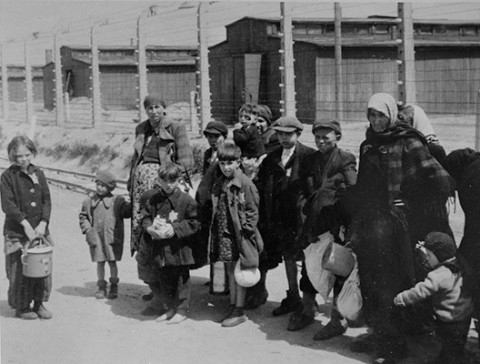 Hungarian Jewish children
walk to the gas chambers at Auschwitz-Birkenau
Hungarian Jewish children
walk to the gas chambers at Auschwitz-Birkenau
The next day after German forces took
over Hungary, Adolf Eichmann arrived to oversee the process of
deporting the Hungarian Jews. There were 725,000 Jews living
in Hungary in 1944, including many who were previously residents
of Romania, according to Laurence Rees, who wrote "Auschwitz,
a New History."
The Jews in the villages and small towns
were immediately rounded up and concentrated in ghettos. One
of the ghettos was located in a brick factory in the city of
Miskolc, Hungary, where 14,000 Jews were imprisoned while they
waited to be transported to Birkeanu.
Magda Brown,
who was born in Miskolc on June 11, 1927, said in a speech at a Synagogue in Morgan Hill, CA
that her family was marched though the city to the Miskolc ghetto
on her 17th birthday in 1944. From there, Magda was transported
on a train to Birkenau, where she was immediately separated from
her family.
After two months at Birkeanu, Magda was
sent, along with 1,000 Hungrian women, to work in a munitions
factory at Allendorf, a sub-camp of Buchenwald. In March 1945,
the prisoners at Allendorf were evacuated and marched to the
Buchenwald main camp; Magda escaped from the march and hid on
a farm until she was rescued by American soldiers.
Vera Frank Federman is another Hungarian survivor who was sent to
Auschwitz and then transferred a few weeks later to the Allendorf
sub-camp of Buchenwald.
The following quote is from an article published on April 29, 2003 in The
Daily, the newspaper of the University of Washington. Vera
Frank is a graduate of UW.
On Federman's 20th birthday, June
27, 1944, she and her parents were herded onto one of the transports
and spent the next three days traveling to Auschwitz.
"We arrived [at] Auschwitz, and
they separated the men from the women, and my father went with
the men, and my mother and I arrived in front of an S.S. officer,"
Federman said.
The officer ordered Federman and her
mother in different directions, despite Federman's claim that
she was only 13 years old. She never saw either of her parents again.
Federman stayed in Auschwitz for six
or seven weeks, and saw her health and that of others rapidly deteriorate.
"Girls came down with scarlet
fever, and my cousin, with whom I came, became ill with scarlet
fever, but she was so lucky, because up to that time, [the Nazis]
took [sick people] immediately, and took them to the gas chamber,"
she said.
After several weeks, Federman and
her two friends, Vera and Zsuzsi, were marched in front of Dr.
Josef Mengele, the camp's human-genetics researcher, so he could
decide which women would be sent to other labor camps, and which
would be killed. Federman and Vera were rejected, while Zsuzsi
was chosen to go to a labor camp.
Zsuzsi insisted that her sister come
with her, and after some questioning by Mengele about whether
they were twins, he approved Vera. Federman tried to convince
Mengele to approve her as well, but he rejected her again.
"I said, 'Oh, but I am very strong,
I can work.' And a German officer standing next to him whispered,
kind of a loud whisper, 'Lassen sie das kleine gehen' - 'Let
the little one go,' and he let me go," she said.
The photo below shows Hungarian women
who have been selected to work.
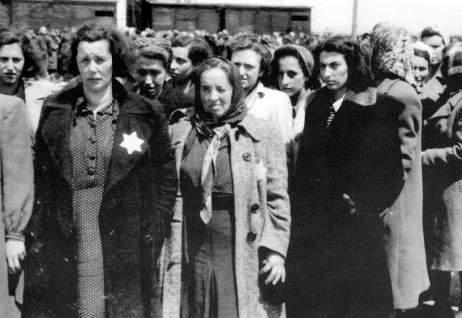 Hungarian women who
have just arrived on a transport train
Hungarian women who
have just arrived on a transport train
According to a book which she wrote, Holocaust survivor
Eva Fahidi was 18 years old when, together with her family
in the town of Debrecen, Hungary, she was herded into a cattle
car headed to the Birkenau death camp. Her Mother and 11-year-old
sister, Gilike, were instantly murdered. Her father bore the
hard labour for a few weeks only.
Eva spent six weeks in Auschwitz-Birkenau.
Then she was shipped with one thousand other women to Allendorf,
a slave-labour sub-camp of Buchenwald. Here, the women
had to work with harmful chemical agents, "without protective
gloves or masks; we inhaled all the dangerous vapour and walked
in saltpeter up to our knees," twelve hours a day, incredibly
hard work, "but in comparison with a death camp it was a
better option." Here, being able "to maintain a reasonable
hygienic standard; in times of great need being able to help
each other," dignified their lives and contributed to survival.
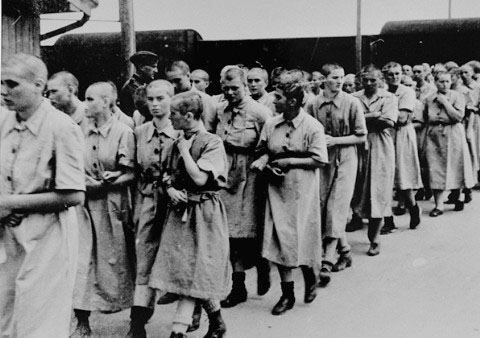 Hungarian women who
have been selected to work at Auschwitz-Birkenau
Hungarian women who
have been selected to work at Auschwitz-Birkenau
The photo above shows Hungarian women
walking into the women's section on the south side of the Birkenau
camp after they have had a shower and a change of clothes. Behind
them is a transport train and in the background on the left is
one of the camp guards. The woman with dark hair in the center
of the photo is Ella Hart Gutmann who is in the outside
row facing inward. Next to her is Lida Hausler Leibovics;
both women were from Uzhgorod. Their heads have been shaved in
an attempt to control the lice that spreads typhus.
One of the Hungarian Jews who survived
was Alice Lok Cahana, whose story was recounted by Laurence
Rees in his book entitled "Auschwitz, a New History."
Alice was 15 when she was registered in the Auschwitz-Birkenau
camp, but months later she was sent to the gas chamber in Krema
V and told that she would be given new clothes after taking a
shower. The purpose of the red brick Krema V building was deceptively
disguised by red geraniums in window boxes, according to Alice.
She was inside the gas chamber in Krema V when the revolt by
the Sonderkommando unit in Krema IV began on October 7, 1944.
This was the occasion when the Sonderkommando blew up the Krema
IV gas chamber building with dynamite that had been sneaked into
Birkenau by some of the women prisoners who worked in factories
outside the camp.
Laurence Rees wrote:
But the revolt did save some lives.
It must have been because of the chaos caused by the Sonderkommando
in crematorium 4 that the SS guards emptied the gas chamber of
crematorium 5 next door without killing Alice Lok Cahana and
her group.
Eva Olsson
is a Hungarian Jew who arrived at Birkenau on May 19, 1944; she
was 18 years old. In a speech at St. Patrick's High School and
St. Christopher Secondary School, as reported by Tara Hagan in
The Observer, a Canadian newspaper, Olsson told about a Nazi
official who came to her neighborhood in Hungary and began rounding
up the Jews, telling them that they were going to be sent to
Germany to work in a brick factory. Instead, they were sent to
Birkenau. Out of 89 members of her family, Eva and her sister
Fredel were the only survivors.
Olsson has spoken to over a million people
since she started giving lectures about the Holocaust in 1995.
In her talks, she tells about the gas chamber at Bergen-Belsen and about children
being burned alive, five at a time, in the crematory ovens at
Bergen-Belsen.
According to the article by Tara Hagan,
Eva Olsson told the students that when the Jews arrived at Birkenau
"People who didn't do what they were told were shot on the
spot. If a mother was holding a baby, they shot the baby and
the bullet would go through to the mother. You save a bullet
that way."
Tara Hagan also wrote that, at the Birkenau
camp, Olssen "recalled living on bread and black, watery
soup that had tufts of human hair in it, bones and mice."
Eventually, Olsson was sent to work in
a factory in Essen, Germany, then to the Bergen Belsen concentration
camp. At Bergen-Belsen, Olsson was starving, covered in lice
and sores and had a fever. She told the students that she "dampened
a cloth with her own urine" in order to cool down. Others,
she recalled, drank their urine.
Iby Knill
was 18 and working as a resistance fighter in Hungary when she
was arrested and eventually transported to the Birkenau death
camp in June 1944, according to this news article by Virginia Mason, published
on January 26, 2010.
Iby's story begins when she was a young girl growing up in her
native Czechoslovakia; when the Germans invaded Czechoslovakia
in 1938, she escaped over the border into Hungary but was arrested
as an illegal immigrant.
"There were five of us, all girls
and we made a pact to stay together as we walked through those
gates and were greeted by the man we later learned was Dr Josef
Mengele," she says of her arrival at Birkenau. "From
that day on it became a test of survival." Miraculously,
she adds, all five of them lived to witness the liberation from
the Nazis in 1945.
By 2010, Iby had started writing her story and was seeking a
publisher for her manuscript, which is chillingly brutal in its
frankness, according to Virginia Mason's article.
According to Iby Knill, "The shower
unit and the gas chamber looked the same. They had been built
that way, so we never knew if we were to be gassed or just showered."
In her lectures on the Holocaust, Iby
describes the infamous Dr Mengele, whose experiments in the name
of medical science earned him the nick name, Angel of Death.
"We lined up and he would walk in front of us, picking out
the weakest. Their fate was the gas chambers."
She talks of the cramped, inhuman conditions
at Birkenau, the incredible hunger and thirst, and worst of all,
the scraps of gray, latherless soap made from human ashes, and
the constant fear of extermination in the gas chamber.
According to her story, Iby was able
to leave the Birkenau death camp only by volunteering to go to
the Lippstadt labour camp, a sub-camp of the Buchenwald concentration
camp, where she worked in the hospital unit. On Easter Sunday,
1945, while on a death march to the main Buchenwald camp, she
was freed by Allied Forces.
The following information about Holocaust
survivor Lily Ebert is from an article by Ross Lydall in the London Evening
Standard on January 26, 2010:
At the age of 14, Lily Ebert was taken
from the Hungarian town of Bonybad to Birkenau in a packed cattle
car, along with her mother, brother and three sisters. Lily was
registered upon arrival in July 1944 and tattooed with the number
A-10572, even though she was below the age of 15 and could have
been sent directly to the gas chamber.
After about four months at Birkenau, Lily
and her three sisters were transferred to an ammunition factory
near Leipzig, Germany, which was a sub-camp of the Buchenwald
concentration camp.
This page was last updated on January
27, 2010
|